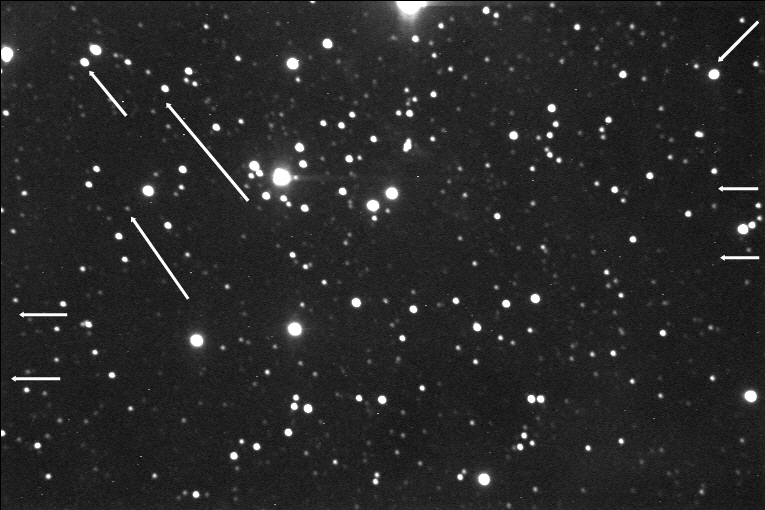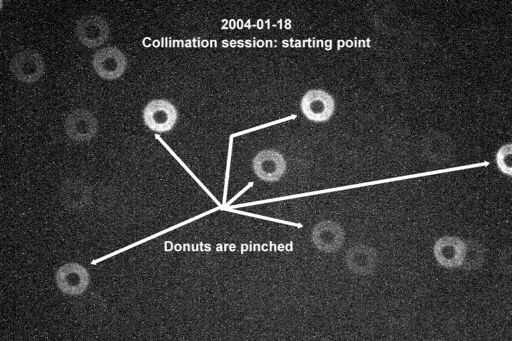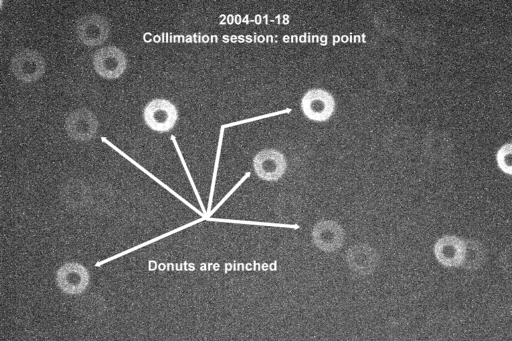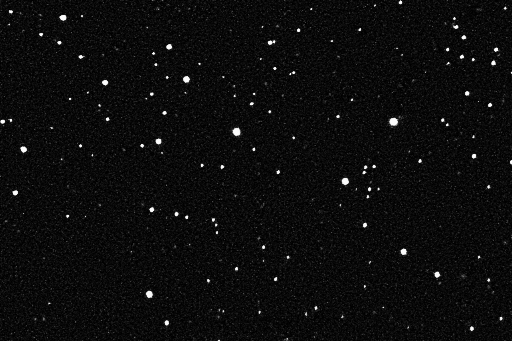
Techniques
- Star Elongation Analysis
The
issue:
| For a long time I've
experienced issues with elongated stars
in my images. Sometimes there's little to
no star elongation in an image, and other
times, the images are ruined by it. |
| Here's an example, this
image is a single 1 minute exposure,
taken through the LX200 with an F6.3
focal reducer. The scope was being guided
by an ST8 imaging through an ETX90 riding
piggyback, and PEC was running. |

Possible
Causes:
| I believe the horizontal
arrows above reflect guiding/tracking
errors, where the stars appear to be
moving from right to left across the
image. However, the diagonal elongations
in the upper corners I believe are due to
collimation problems. I've heard numerous
theories from very knowledgeable people
about what causes these type of problems.
The explanations tend to fall into 3 main
categories, with possible explanations
for each one. |
- Tracking problems
- Here's
a movie I made from 8x1
minute shots like the one
above. I need to re-run
this, unguided and with
shorter exposures.
|
| |
- Inadequate polar
alignment
- Need
to check again. Last time
I checked was in Summer
and it was dead on.
- Poor or no PEC
training
- I
recently erased and
retrained the PEC. I need
to measure it to see what
it's like now
- I've
read that PEC can cause
guiding problems, I may
erase it again and retry
the test with no PEC.
- Scope out of balance
- The
scope was well balanced
in 3 dimensions
- Guiding problems
- Flexure
of the guidescope
- The
guidescope is not well
secured. I'm using a
Losmandy dovetail camera
mount with a single screw
type connection to the
rear of the guidscope,
need to replace with
solid 3 point rings.
- Over
aggressive corrections
- I've
only used the defaults
for agressiveness, so I
could try making
adjustments and trying to
measure the effects. As
noted above, I've heard
that PEC can cause the
guider to work harder so
PEC may be causing over
agressive guiding.
- Mirror
flop
- I
use a mirror lockdown
bolt and I'm pretty
certain my primary isn't
moving around.
- Collimation
- Secondary
collimation
- Per
the image above, I
believe that the
elongation in the top
left and right hand
corners are due to
collimation problems. I
have been working on
collimation but more
needs to be done to get
it right. I tried
collimating while using
the focal reducer and got
poor results. I
collimated again at F10
with better results.
- Focal
reducer spacing or
alignment
- I'm
using the Agos focal
reducer adapter with
distances between scope,
focal reducer and camera
measured out carefully.
- Flexure
of the camera
- The
Agos focal reducer
adapter elimates this
problem.
|
| Next Steps: |
- Working with short
exposures, continue to correct
collimation problems
- Verify polar
alignment
- Verify PEC. Take a
large number of short exposures.
Periodic error can be measured by
plotting movement across all the
frames. Also, the individual
frames can be examined for
elongation which is caused by
collimation problems (since the
short exposure time eliminates
mount problems).
- Get 3 point rings to
lock the guide scope down better.
- Verify guiding by
taking a large number of guided
shots with PEC turned on and off
to see which works better.
- Verify the limits of
guiding by taking guided shots at
various exposure lenghts to see
if there's a maximum cutoff.
- Verify the effects
of guiding agressiveness settings
|
| UPDATE: 2004-01-18 |
| Collimation: I continued to work
collimation issues with some success, but
still not perfect. Here are some out of
focus images that I was using to
collimate with. The first is how it
started out and the second is what it
looked like when I was done. The third
image shows what the in focus results
look like. There is some improvement
although elongation is evident in the
corners and edges. It took 2 hours making
small adjustments to the collimation
knobs just to reach this modest level of
improvement. A nice clear moonless night
went by and I had to endure 10 degree
temperatures so it's disappointing not to
have achieved more progress. 


Polar Alignment: I verified my polar
alignment. It was good, although I did
make a very small RA adjustment. Over 5
minutes a bisected star at over 200x
remains bisected.
PEC: I took 60x10second images after
tweeking polar alignment and collimation.
I found my periodic error to be almost
exactly what it was when I measured it 1
year ago, averaging around 2 arc seconds
between 10 second frames. This still
needs work. The camera wasn't 100%
orthogonal to the scope and I noticed
some dec drift so the polar alignment may
need a little more work as well. I used
the ST8i for this test but would get
better results using the Sac7. Need to
run this again.
Guide scope attachment: I have
purchased a very good set of rings from
Losmandy that should solidify the guide
scope attachment. Haven't tried it yet.
|
| UPDATE: 2004-02-24 |
| Since the last update I received the
Losmandy rings, they are very solid and
work extremely well. I have also
purchased a visual back for the ETX90
that I hope will keep any camera movement
or flexure to a minimum, still need to
try it out. I worked for some time on
the collimation and have it tweaked
pretty well at this point. This was done
as described above, with the camera.
There's no doubt it could be tighter. I
would love a program that could analyze
images and suggest which collimation
screws to turn but as far as I can tell,
none exists.
I erased and retrained PEC very
carefully by hand. I did a learn and 3
updates, all very carefully with my
reticle eyepiece. The mount is tracking
as well or better than it ever has.
|
<< back
|
| |
|